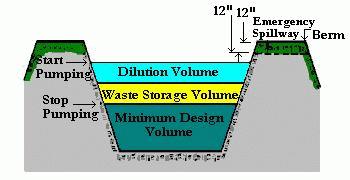Wastewater Lagoons - 4...
Anaerobic Lagoons...
Anaerobic lagoons are the ones most commonly used to treat livestock manure. These lagoons can be deeper since anaerobic
processes do not require free oxygen. This permits a smaller surface area (and thus less odor emission) for a given lagoon
volume.
Advantages of anaerobic lagoons : (1) Anaerobic lagoons require relatively small design volumes and are thus less
expensive to construct. (2) Anaerobic lagoons can decompose more organic matter per unit volume than aerobic lagoons.
Disadvantages of anaerobic lagoons : (1) Anaerobic lagoons are sensitive to sudden changes in temperature and
loading rates and will produce some septic odors as a result. However, serious odor problems seldom occur if the lagoon
is designed and operated properly. (2) Anaerobic lagoons work best during summer and in areas without cold winters since
higher temperatures improve manure decomposition.
Aerobic Lagoons...
Aerobic lagoons are generally considered uneconomical for livestock manure treatment. These lagoons are usually shallow
since aerobic processes require free oxygen. The oxygen is suppled either from the atmosphere by means of mechanical
aeration or from algae as a result of the photosynthetic process.
Advantages of aerobic lagoons : (1) Aerobic lagoons produce fewer offensive odors than anaerobic lagoons. (2)
Mechanically aerated lagoons require only about half of the design volume of anaerobic lagoons.
Disadvantages of aerobic lagoons : (1) A very large land area is required for naturally-aerobic lagoons since
they must be shallow (less than 5-6 feet). Therefore, naturally-aerobic lagoons are very expensive to construct and
impractical for livestock operations. (2) Mechanically aerated systems are too expensive to install and maintain for
most livestock operations. (3) It may be necessary to add bicarbonates in order to maintain the pH between 6.5 and 9.0.
(4) The efficiency of aerobic lagoons decreases during periods of cold weather since the rate of organic decomposition
decreases as temperature decreases.
Single - Stage Lagoons...
Single-stage lagoons are similar to earthen basins, but are designed to treat manure as well as for manure storage.
 Multi - Stage Lagoons...
Multi-stage lagoons work well for livestock manure treatment, especially when the treated manure will be used for
irrigation or recirculation in a flush-type handling system. The first cell, or stage, is usually deep and anaerobic.
The level remains constant in the first cell so that any additions will cause some of the treated effluent to overflow
into the second cell, which is usually shallower and aerobic or facultative. A multi-stage lagoon typically has fewer
odors and organic solids than a single-stage lagoon. Three-stage lagoons are sometimes used where flush water is returned
to the building for manure removal. Water is recycled from the constant-head second stage with the third stage used as a
holding unit before irrigation onto cropland.
Multi - Stage Lagoons...
Multi-stage lagoons work well for livestock manure treatment, especially when the treated manure will be used for
irrigation or recirculation in a flush-type handling system. The first cell, or stage, is usually deep and anaerobic.
The level remains constant in the first cell so that any additions will cause some of the treated effluent to overflow
into the second cell, which is usually shallower and aerobic or facultative. A multi-stage lagoon typically has fewer
odors and organic solids than a single-stage lagoon. Three-stage lagoons are sometimes used where flush water is returned
to the building for manure removal. Water is recycled from the constant-head second stage with the third stage used as a
holding unit before irrigation onto cropland.





